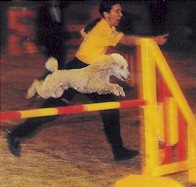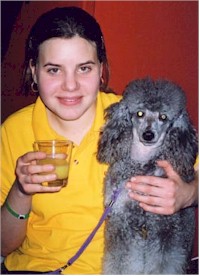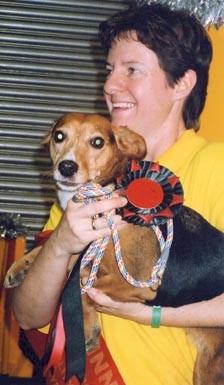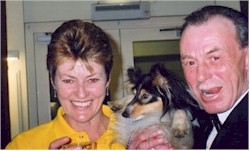'Success is counted sweetest by
those who ne're succeed'
Emily Dickinson
 Getting
to the top of your sport is not easy. It takes more than a good dog and a good handler to make
an agility round look simple. What do the ten Olympia mini finalist have that the rest of us
lack? What turns a competitor into a winner? To find out, Mary Ann Nester went to the Pedigree
Smackos Mini Agility Stakes Final held at the Olympia International Show Jumping Championships
and spoke to the handlers, judge and sponsors. Olympia boasts the most pressurised final in
agility and those who make it there do so not just because they enjoy winning, but also because
they love to do battle. Getting
to the top of your sport is not easy. It takes more than a good dog and a good handler to make
an agility round look simple. What do the ten Olympia mini finalist have that the rest of us
lack? What turns a competitor into a winner? To find out, Mary Ann Nester went to the Pedigree
Smackos Mini Agility Stakes Final held at the Olympia International Show Jumping Championships
and spoke to the handlers, judge and sponsors. Olympia boasts the most pressurised final in
agility and those who make it there do so not just because they enjoy winning, but also because
they love to do battle.
Everyone in agility recognizes that to
be a finalist at Olympia means that you have arrived. Be honest, how low would you sink to get
your hands on that badge of excellence, a Pedigree fleece? Competition for a spot at the Finals
means that Mini handlers travel the length and breath of England to work their dogs in the
qualifying heats. If they make the grade, they fight for a place in the top ten at the
semi-finals in Birmingham. The pressure to produce a winning performance increases with each
stage of the qualifying process and the handlers’ ability to cope with stress will be tested
every time they step on the start line. At the Olympia Finals, they will have only one chance
to get it right. It is not just their friends and family who will be watching them, but the
world. This thought alone is enough to make most people dissolve into jelly.
 The
eyes of the world The
eyes of the world
Don’t you dare tell any of the finalists that
they are there to entertain the crowds! They are out for Pedigree crystal and have put in
better performances and faster times with each passing year. This is what makes ticket sell and
the box office is alive to the agility fans. Witness the discounted seats offered to
Agilitynet readers. Open your Olympia programme and you will find more pages devoted to
agility than ever before. Media coverage increases. Where else would you find a cameraman so
eager to catch a close up of a good-looking girl and her dog that he places himself in her
flight path? Carol Hughes meant business when she knocked him flying. And the Pedigree European
Agility Cup brings in competitors and visitors from abroad. Who wouldn’t be a little bit
nervous with all this attention?
Show time
And what happens when the pressure is on? Panic!
Everyone gets nervous – even the top handlers. What distinguishes a successful competitor from
the rest of us is their ability to recognize a panic attack and control it. A bad case of the
jitters can really jeopardize performance on your big day. Most of the mini handlers I spoke to
at Olympia confessed that they started getting anxious the minute they opened their eyes on the
morning of the final. A few got a bad attack nerves as they stepped on the start line. There
are no international boundaries for stress or anxiety. Lars Bang, who was at Olympia
representing Denmark in the European Cup, joked that he started to get nervous the minute he
posted his entry form. He has run a miniature poodle in the past and, if it was anything like
my poodles, I’m not surprised he felt some trepidation. If you want to win, you have to master
your nerves.
 How
important is winning? How
important is winning?
Most of the mini finalists confessed that they were addicted to the buzz of a good win. That
adrenalin rush is a good feeling and there is nothing like a little success to make you want a
lot more. Why else have you been doing all that training in the cold and wet when you could be
curled up in front of the television with a drink in your hand? Mary Ray has competed at
Olympia twenty times and demonstrated that her confidence in her dogs, her training and her
ability can be an important factor in any winning formula. She has reached the top of the
mountain and stayed there. But being a winner can also bring additional pressure. You start to
anticipate hearing your name called out at prize giving. How do you feel when it isn’t?
In addition, long-time competitors who have been there and done that may feel a lack of
sufficient challenges and, as a consequence, their handling can become blasé.
Turning the negative
into a positive
Winners have to be good losers. There would be only one winner that evening and I asked the
mini finalist how they cope with disappointment. They have all had their fair share. Sharon
Brewster lost a Crufts win when her dog’s bottom remained tantalizingly above instead of on the
table. Jayne Bray’s poodle pooped in the ring at Crufts before the last fence (clear till
then). Keith Leslie had to re-think his training plans when his dog broke a leg. Most swear –
but not loud enough for the judge to hear. All put it behind them. None blame the dog. They
recognize that thinking what went wrong, why and how to prevent it happening in the future is
much more productive. The top handlers know that failure keeps them in touch with the real
world and keeps them learning about their dogs.
 The
winner The
winner
Lisa Bailey has stayed in touch with the real
world more than most. She has had a good size dollop of disappointment. Most of her
eliminations have happened at the last fence. It looks like the round will be faultless and the
crowd is standing in their seats ready to applaud. They let out a great sigh and rapidly sit
down when Lisa breaks the beam before her dog or Peg keeps going with Lisa and doesn’t even see
the final hurdle. At her most negative, I have heard Lisa say, 'I never do well at finals.' At
her most positive, she says, 'I laugh in the face of nerves!' Lisa is always laughing, but she
laughed more than usual on Friday night and look where it took her – right to the top.
Thank you and
congratulations
Thank you to the mini finalist who took the time
to talk to me at Olympia. You were all brilliant. The correct answer to the question, 'How many
teeth should a dog have?' is forty-two. I know many of you spent the day counting your dog’s
teeth after I interviewed you. Only Nicola Williams knew the answer, but she is a veterinary
nurse. Well, it gave you something else to do besides biting your fingernails or smoking while
you waited for the course to be ready to be walked.
 But
it is not just the handlers who have to contend with nerves. Dave Ray seems to be everywhere at
once, but managed to stand still long enough to chat with me. He is definitely a man who knows
how to work under pressure and I have rarely seen someone look so calm in the face of danger -
ten hot-wired mini handlers. Thanks Dave for keeping Pedigree in agility. Kathrin Tasker looked
gorgeous and can keep her cool whether she is competing with her dogs or standing out in the
middle of the arena judging contacts. Liz and Allan Pollock from Premier remained calm in the
knowledge that good preparations ensure success. They had brought enough equipment to run
several more rings and plenty of tinsel. You know it’s Christmas when there’s tinsel on your
A-frame. But
it is not just the handlers who have to contend with nerves. Dave Ray seems to be everywhere at
once, but managed to stand still long enough to chat with me. He is definitely a man who knows
how to work under pressure and I have rarely seen someone look so calm in the face of danger -
ten hot-wired mini handlers. Thanks Dave for keeping Pedigree in agility. Kathrin Tasker looked
gorgeous and can keep her cool whether she is competing with her dogs or standing out in the
middle of the arena judging contacts. Liz and Allan Pollock from Premier remained calm in the
knowledge that good preparations ensure success. They had brought enough equipment to run
several more rings and plenty of tinsel. You know it’s Christmas when there’s tinsel on your
A-frame.
Congratulations to everyone for making
the day a big success. Thank you for allowing me behind the scenes and sharing a little bit of
it with me. You are all winners!
 About
the author... About
the author...
Mary Ann Nester is a member of
APDT. Born in the USA, she came to Britain in 1972 as a student. She has pursued a mixed career
- fruit picker, gymnastic coach, keep-fit instructor and academic librarian. In 1997 she set up
Aslan Enterprises, a dog-training school named after her first agility dog.
Running Aslan, a lurcher dog, at agility
competitions got Mary Ann hooked on the sport and Bounty, a German Shepherd Dog, and Tam, the
Border Collie were soon added to the household.
Mary Ann's most successful dog to date has been Brillo
Pad, a Miniature Poodle who took her to Olympia and Crufts. Brillo also competed in the Draw
Challenge on National Lottery Live!, winning Mary Ann the privilege of pushing the button that
released the evening's lottery balls in front of millions of television viewers.
Daz, another miniature poodle and most recent addition,
was bought for competition in the Mini ring, but grew too tall! He has proved that size doesn't
matter. He entertained the crowds at Olympia as one of the 'fun dogs' and has strut his stuff
in the ABC competition (Any Breed but Collie) at Crufts.
Mary Ann is a member of the first British Team to compete
in the FCI World Championships 2001 in Portugal.
She has recently moved to Northamptonshire and writes
regular articles for both The Agility Eye and Agility Voice as well as
Agilitynet.
Photos: © Mary Ann Nester 2001
|